Buses and coaches: features and help for disabled people
Published 24 May 2024
Applies to England, Scotland and Wales
Overview
The law says that buses and coaches must have features for disabled people, and that drivers must give them help.
The law covers single deck and double-deck buses and coaches.
The law sets out rules for:
- help getting on and off a bus or coach
- ramps and lifts
- using a wheelchair
- travelling with an assistance dog
- priority seats (buses only)
- seat armrests (coaches only)
- steps and stairs
- handrails, poles and handholds
- floors and aisles
- ‘stop’ or bell buttons (buses only)
- route and destination displays
The full names of the regulations are:
- The Public Service Vehicles (Conduct of Drivers, Inspectors, Conductors and Passengers (Amendment) Regulations 1990 (as amended)
- The Public Service Vehicles Accessibility Regulations 2000
Buses and coaches that do not have to follow the rules
The law does not apply to:
- minibuses or buses or coaches that can only carry 22 or fewer passengers
- private or hired buses or coaches that do not run on a timetable
Some coaches do not have to meet all of the rules until 1 August 2026. They are:
- home to school services
- rail replacement services
1. Help getting on and off the bus or coach
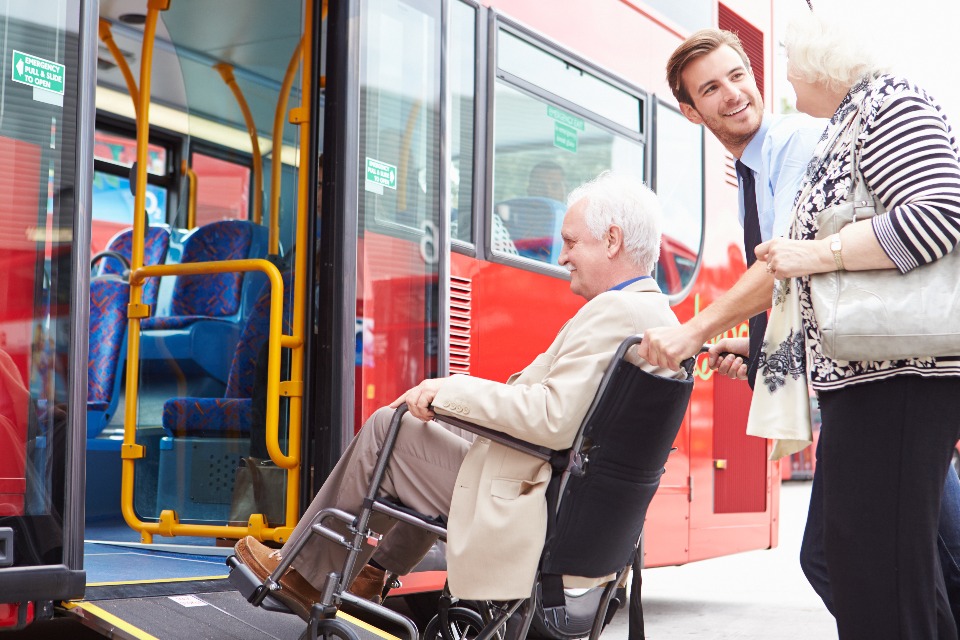
The driver must:
- help you get on and off the bus or coach if you’re disabled and you ask for help
- offer you help to use the wheelchair space restraint system
The driver does not have to physically lift passengers or heavy mobility equipment.
The driver does not have to give you help if they reasonably think that there will be a health, safety or security risk to:
- you
- themselves (the driver)
- other passengers
2. Ramps and lifts
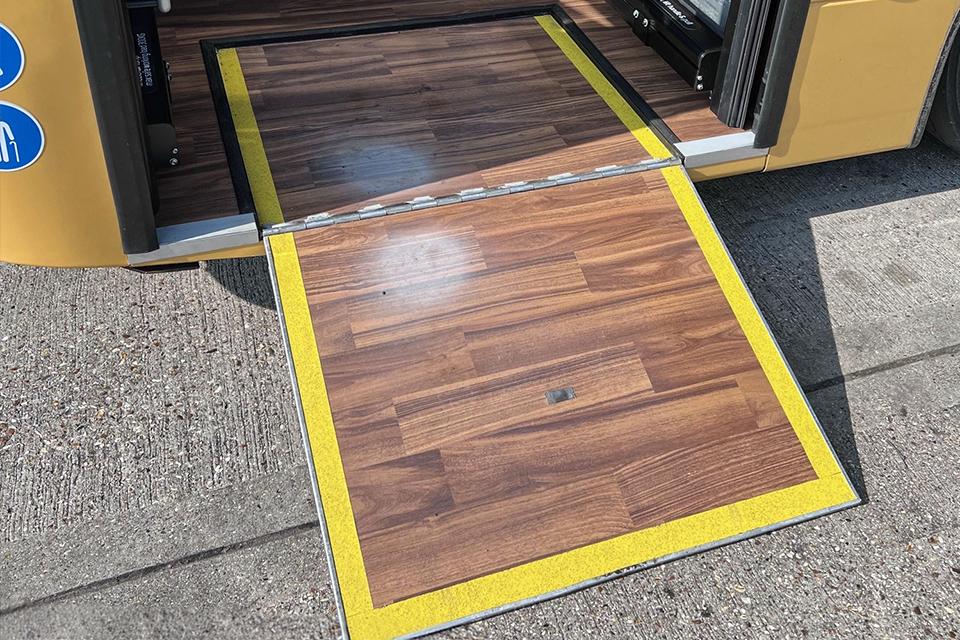
An example of a ramp that folds out.
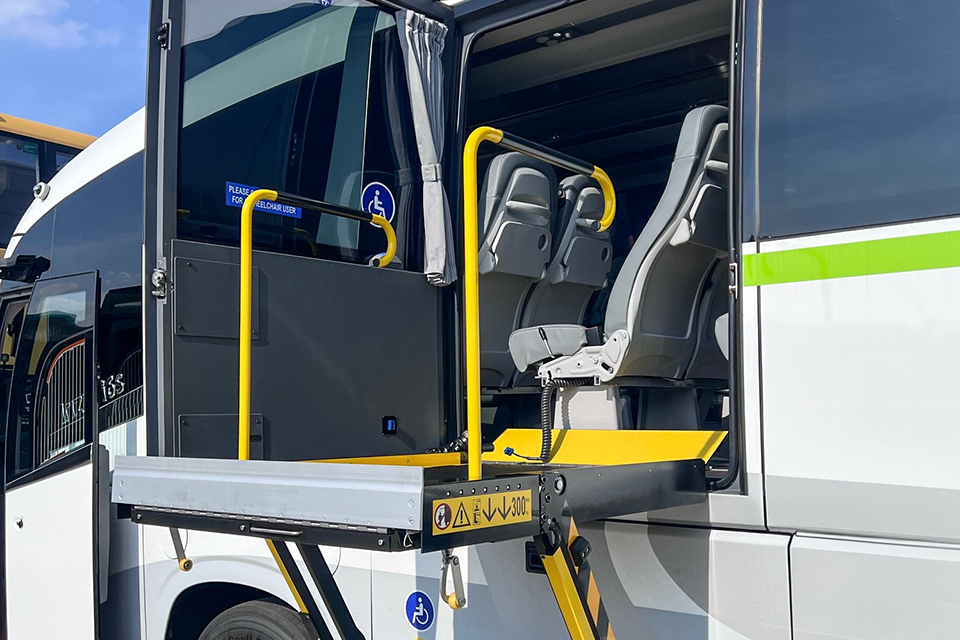
An example of a coach with a powered lift.
The bus or coach must have either a working lift or ramp to help you get on and off the vehicle.
This could be a:
- powered lift
- powered ramp or manual ramp that slides or folds out
- portable, detachable ramp that is stored on the vehicle
When you want to get on or off the vehicle, the driver must make sure the ramp or lift is safe to use.
3. Using a wheelchair
The law only applies to wheelchairs and electric wheelchairs. It does not apply to mobility scooters.
The driver must let you on the bus or coach if you’re using a wheelchair.
The driver can only refuse to let you get on if either:
- your wheelchair is larger than a standard wheelchair
- your wheelchair cannot be safely located in the wheelchair space
- letting you on to the bus or coach would take it over the maximum seating or standing capacity
- there is already a wheelchair in the wheelchair space
The law says that a standard wheelchair is:
- 70cm wide
- 120cm long (front to back)
- 1.35m high
If other passengers are in the wheelchair space
If other passengers or their belongings are in the wheelchair space and the bus or coach is not full, the driver must ask them to move.
If the passenger refuses without a good reason, the driver should tell them they are required to move.
Drivers do not have legal powers to actually move passengers from the wheelchair space.
If the passenger still refuses, the approach the driver takes will depend on the circumstances. Most bus and coach companies will have their own policy for dealing with this. It might include:
- the driver trying to persuade the other passenger to move
- telling the driver not to set off until the situation is resolved (if it would not make other passengers late)
- organising and paying for alternative transport for you, such as a taxi
- banning disruptive passengers from travelling in the future for breaking their ‘conditions of carriage’ if they cover this
Check the service operator’s policy.
Design of the wheelchair space
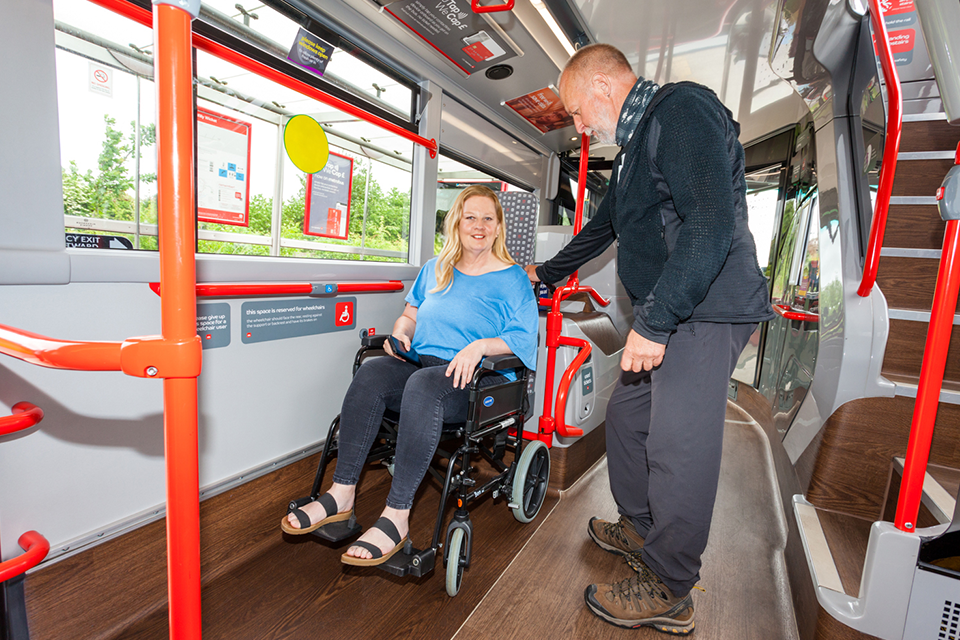
The bus or coach must have at least one space for a standard wheelchair.
The space must:
- face either the front or rear of the vehicle
- have a wheelchair user restraint system if it faces the front (this looks like a seat belt)
Next to the space, there must be:
- a sign that shows which way you will face
- safety instructions explaining the use of the wheelchair space
If the wheelchair space contains seats they must:
- be able to be removed or fold out of the way so you can use the wheelchair space
- have a sign near them that says ‘please give up this seat for a wheelchair user’ (or similar)
Wheelchair signs
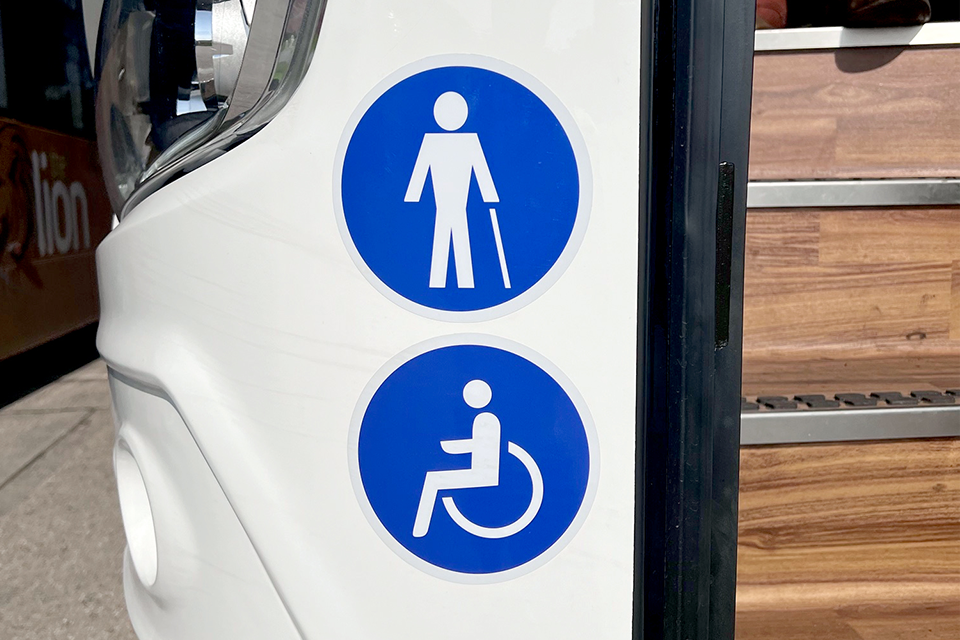
An example of a wheelchair sign on the outside a coach.
There must be wheelchair signs:
- on the outside of the bus or coach, next to any entrance for a wheelchair user
- on the inside of the bus or coach, next to any exit for a wheelchair user
- next to any wheelchair space
The signs should show a white wheelchair symbol on a blue background.
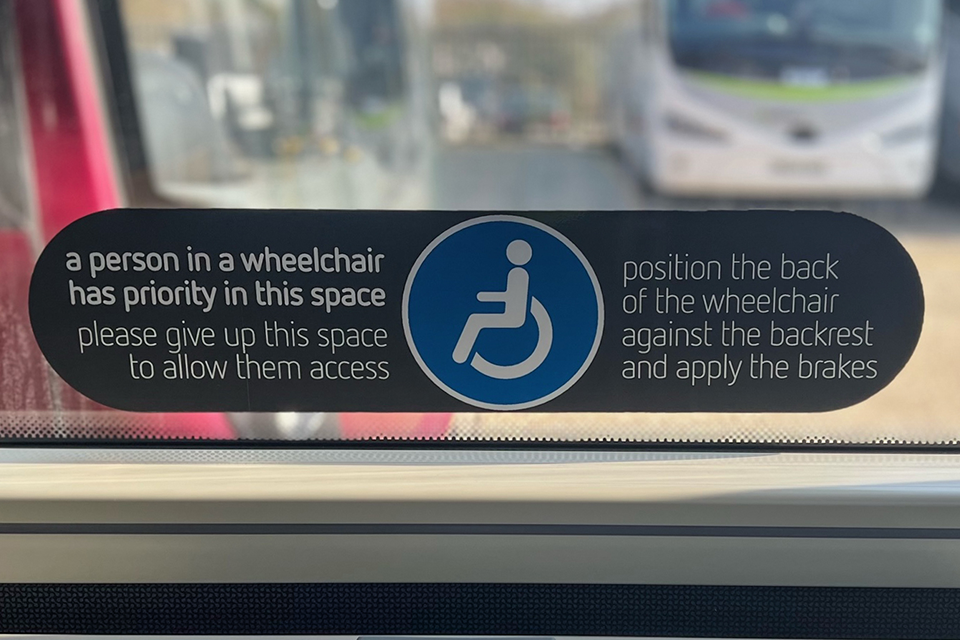
An example of a sign next to a wheelchair space.
Lighting to help you get on and off safely
The bus or coach must have lighting inside and outside to allow you to get on and off the vehicle safely in your wheelchair.
4. Travelling with an assistance dog
The driver must let you on the bus or coach if you have an assistance dog. They’re only allowed to refuse to let you on if either:
- there is no suitable space for your assistance dog
- letting you on to the bus or coach would take it over the maximum seating or standing capacity
- you have bulky belongings with you
- you have something with you that is likely to annoy other passengers
- you have something with you that could injure someone or damage their property
Your dog must sit under or in front of your seat. It must not block the aisle or exit.
Once you’re on the bus or coach, the driver is not allowed to ask you to get off early.
What counts as an assistance dog
In the law covering bus and coach travel, the only dogs that count as an assistance dog are ones that have been trained either:
- to guide a blind person
- to help a deaf person
- by a specified charity to help someone who has a disability that either consists of epilepsy, or that affects their mobility, manual dexterity, physical co-ordination or ability to lift, carry or move everyday objects
5. Priority seats (buses only)
The bus must have a priority seating area for disabled people. The area must:
- have at least 4 seats
- have a sign that clearly shows it’s a priority seating area
- be as close as possible to the priority entrance
- not have any steps
- not have a steep slope or incline
Priority seats must:
- face the front or rear of the bus or coach (they cannot face the sides)
- not be able to be tipped, folded or moved
Priority seats with armrests
If the priority seats have armrests, they must be able to be moved out of the way so you can easily access the seats if you have a disability.
Space for assistance dogs
At least one of the priority seats must have enough space for an assistance dog to sit or lie down either:
- under the seat
- next to the seat (but not in the aisle)
6. Seat armrests (coaches only)
If coach seats have armrests, they must be able to be moved out of the way so you can easily access the seats if you have a disability.
7. Steps and stairs
All steps and stairs on a bus or coach must:
- be slip-resistant
- be designed so that front edges minimise the risk of tripping
- have front edges that contrast with the rest of the step so the edges are easy to see
8. Handrails, poles and grab handles
Handrails and poles you can hold on to on a bus or coach must:
- be fitted along one or both sides of the aisles (buses only)
- be fitted above any steps (coaches only)
- be fitted near a wheelchair space
- be a colour that clearly contrasts with the rest of the vehicle
- have a slip resistant surface
- be easy to grip
- not block access to the priority seating area or wheelchair space
Grab handles (buses only)
Grab handles (called ‘handholds’ in regulations) are handles that usually hang down the length of the bus aisle.
The handles must:
- be at least 80cm from the floor and no higher than 1.9m
- have a loop shape (or some other design) that stops your hand from slipping from it
- be slip-resistant
- be easy to firmly grip
- contrast with the parts of the bus next to it
9. Floors and aisles
All bus and coach floors must be made of slip-resistant material.
The aisle (sometimes called a gangway) must be wide enough for a standard wheelchair to get from:
- the entrance to the wheelchair space
- the wheelchair space to the exit
10. ‘Stop’ or bell buttons (buses only)
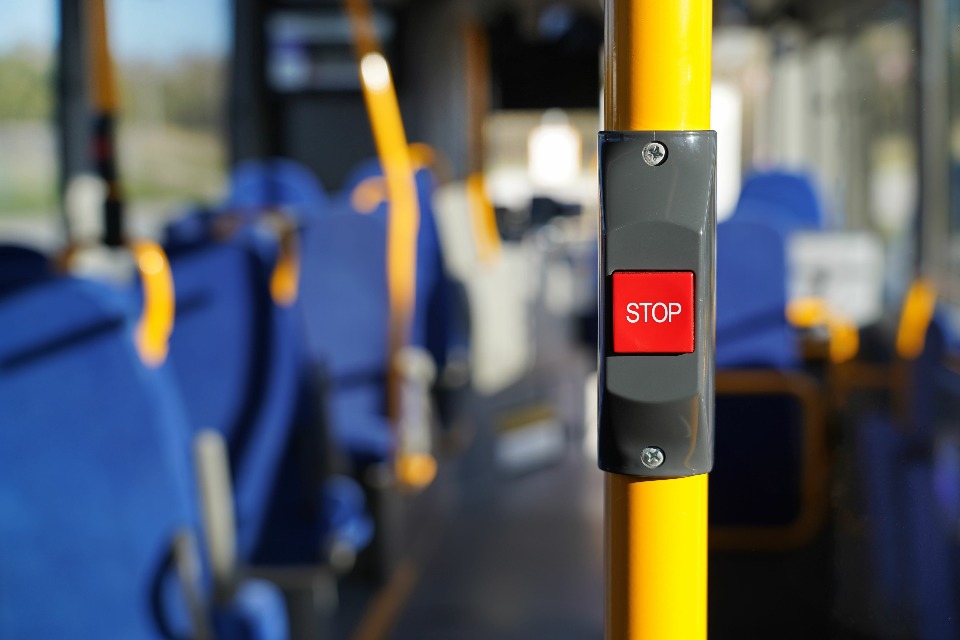
The bus must be fitted with buttons so you can tell the driver you want to get off at the next stop.
Stop buttons must:
- be within reach of anyone sat in a priority seat
- be next to every third rows of seats as a minimum
- be easy to press
- be a colour that clearly contrasts with its surround - and the surround must clearly contrast with what it’s mounted on
- provide a signal to the driver to stop the bus
- make a sound that passengers can hear
‘Stopping’ sign
When you press the button, it must light up at least one sign on every deck that says ‘Stopping’ (or similar). The signs must:
- be easy for most seated passengers to see
- not be written in block capitals
- stay lit up until one of the doors is opened
11. Route and destination displays

The bus or coach must display the:
- route number and destination on the front of the vehicle
- route number and destination on the side of the vehicle, next to the entrance door nearest the front
- route number on the back of the vehicle
The displays must:
- have a good contrast between the letters and numbers and the background
- be lit up between sunrise and sunset
- not show the destination in block capitals
- be able to show route numbers with at least 3 numbers or letters
- be able to show destinations with at least 15 letters
Check technical details about the rules
You can read the:
- technical details of the rules for wheelchair accessibility
- technical details of the rules for buses
- technical details of the rules for coaches
These includes things like:
- rules on the size some of the features or how far apart they must be
- how some equipment must be operated by the driver
